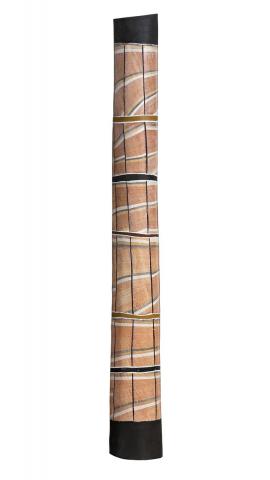LORRKON, 2006
JOHN MAWURNDJUL
natural earth pigments on carved hardwood hollow log
185.0 cm height
Maningrida Arts and Culture, Northern Territory
Company collection, Melbourne
See Museum Tinguely, Basel and Kaufmann, C. (eds), rarrk: John Mawurndjul: Journey through Time in Northern Australia, Schwabe Verlag, Basel and Crawford House, Adelaide, 2005, p. 139 for an earlier Lorrkon by the artist
The Lorrkon or bone coffin ceremony was the final ceremony in a sequence of mortuary rituals celebrated by the people of Arnhem Land. This ceremony involves the placing of the deceased's bones into a hollow log which was decorated with painted clan designs and ceremonially placed into the ground where it remained until it slowly decayed over many years.
'I also make make Lorrkon - hollow log - all painted with my rarrk, filled with Mardayin power.'1
Lorrkon 2006 was painted during the time John Mawurndjulwas working on his major commission for the Musée du quai Branly, Paris. As one of the eight Australian artists selected by the project architect Jean Nouvel to integrate Australian indigenous art into the structure of the building, Mawurndjulwas commissioned to paint a colossal column and another of his works was reproduced on the ceiling of the museum bookshop. Although highly sacred by nature, Mawurndjul chose to depict Mardayin ceremonial themes on the Branly column and indeed our Lorrkkon also depicts an abstract representation of this ancient ceremony.
Mawurndjul is a Kurulk clansman, the son of the 'clever man' and master weaver of fish traps, Anchor Kalunba who taught him about the rituals and ancestral stories associated with the powerful sites of the Kurulk clan estate. His early works were concerned with representing the animals and beings central to Kuninjku culture such as Ngalyod, the rainbow serpent, who inspires intense fear and trepidation among the Kurulk. It was in the bodies of these beings that he began to develop the intricate blocks of fine rarrk for which he has become renowned. 'I filled my brain up with ideas. Into my brain I saw cross hatching designs. I painted these designs (in ceremony) and then I thought I'd use the cross hatching on bark.'2 For Mawurndjul, rarrk is not merely a painting technique, it is integral to the Marday in ceremony and at times he interposes the two as one and the same thing. He reflects, 'I had a dream about the Mardayin ceremony... I know all aspects of the Mardayin ceremony. It is crosshatching design.' The cross hatching evolved to represent the power of the ceremony as though it is a hidden language that allows him to paint the 'inside' things and not simply the public aspects of this sacred ceremony.
In addition to the permanent installation of his work in the Musée du quai Branly, Paris in 2006, John Mawurndjul has received numerous awards and his work has been exhibited throughout the world. He has won the National Aboriginal and Torres Strait Islander Art Award for Bark Painting on two occasions (1999, 2002), The Clemenger Contemporary Art Prize in 2003 and in 1996 his work was included in Universalis: 23 Bienal Internacional Sao Paulo, Brazil. In 2005 a major retrospective of the artist's work was exhibited at the Museum Tinguely, Basel, Switzerland.
1. Kohen, A, interview with Apolline Kohen and John Mawurndjul, in Museum Tinguely, Basel and Kaufmann, C.(eds), rarrk: John Mawurndjul: Journey through Time in Northern Australia, Schwabe Verlag, Basel and CrawfordHouse, Adelaide, 2005, p. 28
2. Perkins, H., Crossing Country: The Alchemy of Western Arnhem Land Art, Art Gallery of New South Wales, Sydney, 2004, p. 135
